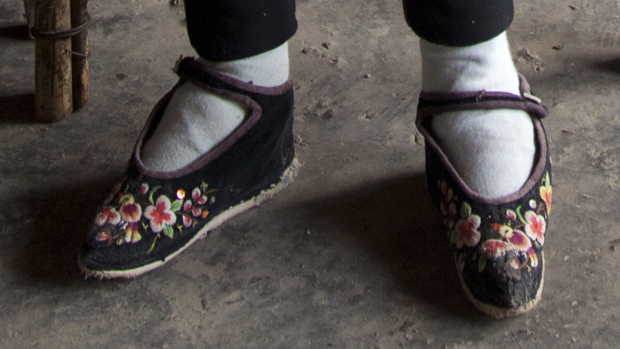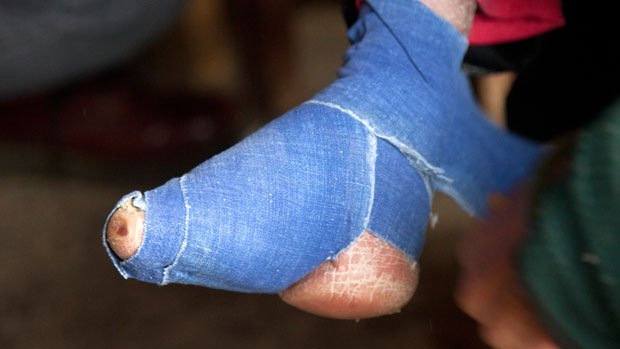Yang Zhaoshi's story: tiny feet, enormous brutality
Our China correspondent meets one of the few women alive who were forced to have their feet bound

IT IS STILL possible in today's China of cloud-busting skyscrapers, superfast bullet trains and glitzy shopping malls to be brought up short by the brutal traditions of the past.
I found Yang Zhaoshi perched on a rattan chair in the courtyard of her family home in a farming village in Yunnan province. "I can't really remember how old I am," she told me. "But I know I was born in the year of the ox."
What was striking was not her age - she was actually about to turn 100 - but her tiny feet: they measured just over 10cm in length.
The Week
Escape your echo chamber. Get the facts behind the news, plus analysis from multiple perspectives.

Sign up for The Week's Free Newsletters
From our morning news briefing to a weekly Good News Newsletter, get the best of The Week delivered directly to your inbox.
From our morning news briefing to a weekly Good News Newsletter, get the best of The Week delivered directly to your inbox.
Yang is one of the few women still alive who was forced to suffer the ordeal of foot-binding - a tradition that began as a status symbol, became a form of female subjugation and eventually a sexual fetish.
"It was so painful, but my mother said that if I didn't do it I would never find a husband, nobody would have me," said Yang, a widowed mother of four, a grandmother, great-grandmother and great-great-grandmother of more children than she can immediately recall. "It wasn't a strange thing to do in those days - many girls in Liuyi [her village] had small feet. The tradition was strong here. If your feet were small, you were admired, you were special." The foot-binding process began when a girl was between four and seven years old. Yang was six.
First, her feet were soaked in warm water or animal blood mixed with herbs. With her toenails clipped short, she was given a soothing foot massage.
Then the horror would begin. Every toe - except for the big one - would be broken and folded under the sole to mould each foot into the shape of a so-called "golden lotus", revered for centuries in China as the epitome of feminine beauty and refinement.
A free daily email with the biggest news stories of the day – and the best features from TheWeek.com
Then the foot was wrapped with binding cloth. Every day, the foot would be unwrapped and wrapped again, but tighter. The youngster's feet would be squeezed into smaller and smaller shoes and moulded by hand to create a high arch and a hoof-like appearance until the foot was between 7cm and 10cm long.
Yang's shattered feet would set that way - and remain deformed for life. While legend says that the practice began thousands of years ago, written evidence suggests it likely was adopted in earnest much later, at the court of the Song dynasty (960AD-1279).
Scholars agree that binding was a sign of social status: if a woman's feet were bound, and therefore she was unable to perform manual labour, she would be viewed as being of the noble class. Others insist foot-binding was a form of female subjugation, and that it gradually became a sexual fetish for Chinese males. What is certain is that foot-binding slowly spread to the lower classes aspiring for higher social status.
Yang remembers that, while mothers or other female relatives traditionally initiated the daily foot-binding process, the victims were expected to take over the agonising, crippling ritual within weeks. "It would hurt so much, but others would laugh if you couldn't manage it, so I forced myself," Yang said.

Today, however, she requires a helping hand with her feet. "I'm old now and it isn't easy to bend, so my second-son's wife does it," Yang said, nodding towards her 70-something daughter-in-law. "It only takes a minute," the woman offered, stepping forward, crouching at Yang's side and smiling broadly. "Would you like to see?" Without waiting for an answer, she snatched Yang's right leg, crossed it over the left leg and removed her black felt shoe, which was ornately embroidered with colourful flowers and songbirds. She whipped off Yang's sock and deftly unwrapped the faded blue-canvas binding, quickly revealing the gnarled, scaly and slightly pungent foot beneath.
Yang's smallest toes had been crushed almost flat, and a shockingly deep cleft - the result of unnaturally forcing the arch upward, thereby reducing the foot's length - ran between the heel and the ball of her foot. Yang was born just one year after foot-binding was banned in China, in 1912, following the fall of the imperial Qing dynasty and the establishment of a republic. The practice, viewed by the new nationalist regime as backward and shameful, continued furtively in remote areas, however. Largely isolated from the authorities, the area around Liuyi was one of the last places in China to abandon the ritual, and girls' feet were still being bound as late as the early 1950s - even after the communists had come to power in 1949 and Mao Zedong had famously extolled gender equality by declaring that women "hold up half the sky". Even in the late 1990s, there were still more than 200 women with bound feet living in and around Liuyi. Today, there are fewer than 20. "The mountains are high and the emperor is far away," said Yang's eldest son, employing an ancient Chinese proverb to explain how foot-binding persisted despite the ban.
Dressed in a blue Mao jacket and cloth cap, he looked every bit as out-of-time in today's China as his mother. "[Foot-binding] was kept secret," he said. "If government officials came, the village girls would be locked away. Once the officials had gone, life would carry on as normal."
-
 Why is Trump’s alleged strike on Venezuela shrouded in so much secrecy?
Why is Trump’s alleged strike on Venezuela shrouded in so much secrecy?TODAY'S BIG QUESTION Trump’s comments have raised more questions than answers about what his administration is doing in the Southern Hemisphere
-
 Vance’s ‘next move will reveal whether the conservative movement can move past Trump’
Vance’s ‘next move will reveal whether the conservative movement can move past Trump’Instant Opinion Opinion, comment and editorials of the day
-
 Why recognizing Somaliland is so risky for Israel
Why recognizing Somaliland is so risky for IsraelTHE EXPLAINER By wading into one of North Africa’s most fraught political schisms, the Netanyahu government risks further international isolation
-
 How Bulgaria’s government fell amid mass protests
How Bulgaria’s government fell amid mass protestsThe Explainer The country’s prime minister resigned as part of the fallout
-
 Femicide: Italy’s newest crime
Femicide: Italy’s newest crimeThe Explainer Landmark law to criminalise murder of a woman as an ‘act of hatred’ or ‘subjugation’ but critics say Italy is still deeply patriarchal
-
 Brazil’s Bolsonaro behind bars after appeals run out
Brazil’s Bolsonaro behind bars after appeals run outSpeed Read He will serve 27 years in prison
-
 Americans traveling abroad face renewed criticism in the Trump era
Americans traveling abroad face renewed criticism in the Trump eraThe Explainer Some of Trump’s behavior has Americans being questioned
-
 Nigeria confused by Trump invasion threat
Nigeria confused by Trump invasion threatSpeed Read Trump has claimed the country is persecuting Christians
-
 Sanae Takaichi: Japan’s Iron Lady set to be the country’s first woman prime minister
Sanae Takaichi: Japan’s Iron Lady set to be the country’s first woman prime ministerIn the Spotlight Takaichi is a member of Japan’s conservative, nationalist Liberal Democratic Party
-
 Russia is ‘helping China’ prepare for an invasion of Taiwan
Russia is ‘helping China’ prepare for an invasion of TaiwanIn the Spotlight Russia is reportedly allowing China access to military training
-
 Interpol arrests hundreds in Africa-wide sextortion crackdown
Interpol arrests hundreds in Africa-wide sextortion crackdownIN THE SPOTLIGHT A series of stings disrupts major cybercrime operations as law enforcement estimates millions in losses from schemes designed to prey on lonely users